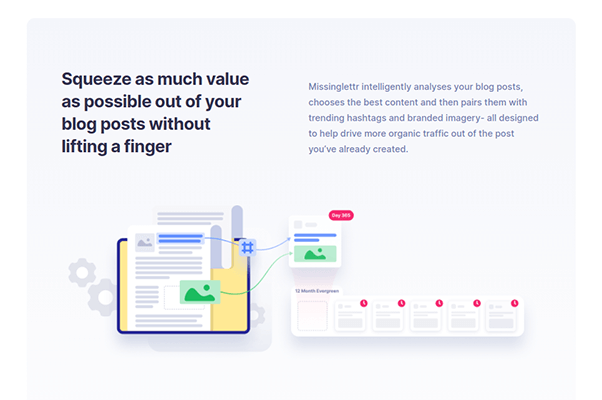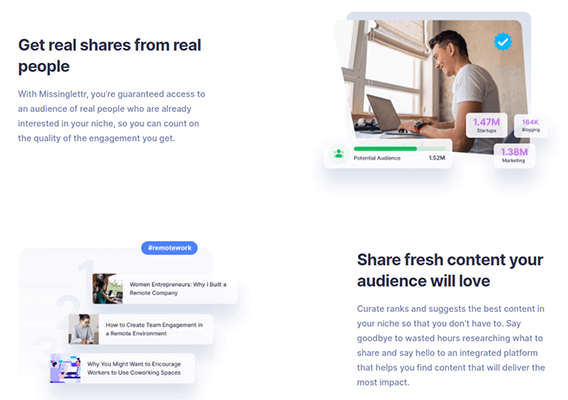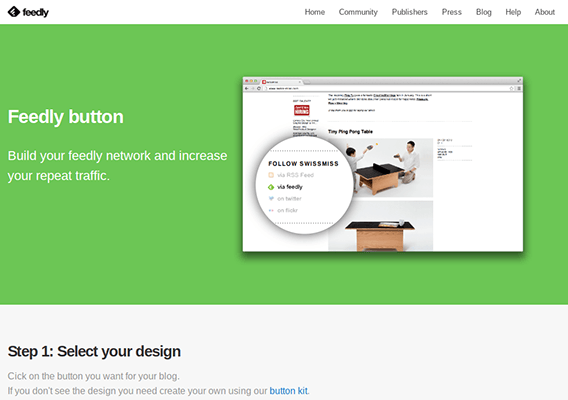How To Promote Your Blog With Automation

Do you struggle with finding the time to promote your blog?
There are plenty of ways to promote your blog manually, but it’s hard to find the time to implement such strategies.
In this post, we share five methods you can use to promote your blog through automation.
Ready? Let’s get started.
How to promote your blog and fix some of your biggest problems
Promoting content is already a problem in and of itself, but there are plenty of other problems bloggers face that tie directly into content promotion.
For starters, more than 50% of bloggers claim that receiving traffic from Facebook has become more and more difficult. 20% add receiving traffic from Google to that list.
What’s worse is the fact that bloggers earning $50k a year or less expect content to spread organically. Their revenue is affected negatively when it doesn’t.
Furthermore, among newer bloggers:
- 79% find it difficult to receive traffic and grow an audience
- 63% have trouble finding the time to create content
- 62% struggle with publishing content consistently
Clearly, the time of publishing well-written, SEO-friendly content and having it rank organically has long been over.
Many of the problems bloggers face can be solved with proper content promotion. If you spend more time promoting content you already have over creating more content, you’ll be able to drive more traffic to your blog and raise its authority over time. Organic traffic will soon follow.
Plus, earning that growth with less content will help you stick to a consistent editorial schedule as you won’t need to waste as much time creating more and more content to make up for old content that never panned out.
Unfortunately, content promotion is just as difficult to work into your schedule as content creation is. For example, guest posting and backlink outreach are two of the most effective content promotion strategies you can use, but they’re incredibly time consuming.
For bloggers with very little time on their hands, automation is definitely the way to go.
How to promote a blog the easy way with automation
We have five methods to share with you to help you promote your blog with automation:
- Use a content promotion service – A content promotion service uses its own resources and network to promote your content across several social media platforms. It’s the easiest way to promote your content, but it will come at a cost.
- Use a social media management tool – Many social media management tools have a feature that promotes your latest blog posts on social media automatically as soon as they’re published. Some even allow you to fill your social media queue with promotions for older content.
- Become part of a content curation program – Become an active member of a content curation program in which you and other members of the program share each other’s content on social media.
- Create an email series for old content – Email segmentation gives you the perfect opportunity to send targeted content to the right group of subscribers. You can set this up automatically with certain email marketing services.
- Optimize your RSS feed – RSS isn’t as popular as it used to be, but some readers still rely on feed readers to receive the latest content from their favorite blogs. Fortunately, your blog already has an RSS feed. All you need to do is optimize it.
Let’s talk about each one of these.
Method #1: Use a content promotion service
A content promotion service is the easiest way to promote your content. That’s because you’ll pay another service to do it for you.
Does it actually work? Let’s use one of the most popular services out there as an example: Quuu Promote. Quuu Promote is a separate service offered by the content curation tool Quuu.
This gives the service an edge over its competitors. Quuu makes it easy for you to find influencers and trending content in over 500 categories. You then connect the tool to your preferred social media management tool, then use the integration to fill your feeds with curated content in your niche.
This is how you know the content you add to Quuu Promote gets shared by real people in your niche, but just how effective is the service overall?

A Better Lemonade Stand used the service to promote 170 articles. Here are two key pieces of data from their results:
- The majority of their posts were shared between 200 and 400 times each with 89 receiving between 300 and 400 shares.
- Most posts received between 100 and 200 clicks.
These are great results considering the service costs $75/month for 10 posts with three content variations for Facebook, Twitter and LinkedIn. Plus, it’s all automated as the service uses your RSS feed to find new articles to promote and includes appropriate hashtags along with the author’s name automatically. Images are pulled from your posts.
There is a cheaper $50/month plan, but it removes the automation and requires you to write your own social media posts.
Note: Every post submitted is manually approved and checked against a list of criteria. To ensure quality, Quuu Promote may reject content that isn’t a good fit or ask you to make changes. This is a good thing for everyone. Better content means you’ll get more value out of the platform.
Method #2: Use a social media scheduling tool
Social media scheduling tools provide another easy way to promote your content on social media automatically. The only major difference is you’ll be relying on your own audience as opposed to a third-party’s network.
SocialBee is a great option if you still need a tool to plan out your social media calendar. It allows you to set up Zapier or your RSS feed to create new social media posts automatically every time you publish a new blog post.

You can set up a schedule and require approval before any posts get published to your social media profiles. This gives you time to make any necessary changes to auto-generated posts.
SocialBee even has categories you can set up to organize your social media content much more efficiently. There are also two crucial labels you can apply to each post: Share Once and Evergreen.
When you assign the Share Once label to a post, you’ll only publish the post to your chosen social media feeds once. Evergreen posts get sent to the bottom of the queue after they publish.
Speaking of, SocialBee’s social media queue and evergreen label offer another way for your social media management tool to promote your blog. The tool’s queue is the collection of articles you’ve scheduled to be published in the order you’d like them to be published.
In general, the tool will only publish social media posts at the times and on the days you chose when you set up your account.
The addition of the queue allows you to add posts that promote your latest content back into your social media calendar so you can promote the post again at a later day.
Alternatives to SocialBee
SocialBee is a powerful social media publishing tool, but what if it’s overpowered in terms of what you want to accomplish with it?

That’s where a WordPress plugin like Revive Old Posts comes into play. This simple plugin allows you to keep your social media feeds filled with old content automatically.
You’ll never run out of opportunities to breathe new life into some of your older yet still relevant content.
Missinglettr is another fantastic option and takes a slightly different approach to social media scheduling compared to SocialBee.
Instead of requiring you to manually create social media posts, it includes a campaign builder that automatically turns your blog posts into social media posts for popular networks.

This feature analyzes your content in search of shareable quotes and images, then uses that content to generate new social media posts.
This feature definitely sets Missinglettr apart from other social media publishing tools.
Method #3: Become part of a content curation program
Quuu Promote is a content curation program, only it works as a premium service so you don’t need to contribute in order to have your content promoted within the network.
The content curation program we’re going to discuss in this method has its content promotion service integrated directly into its content curation tool. They’re not separate from one another.
It’s called Curate, and it’s available as an add-on for Missinglettr customers.

Curate is a content curation network comprised of you and other Missinglettr users, at least those on the premium plans. You can use it to find quality content in your niche to share with your audience.
Plus, it works both ways. While you add other bloggers’ content to your feed, you can add your own posts to the program so they can share your content as well.
The tool even has built-in analytics, so you’ll be able to track the number of people who have your content scheduled in their social media feeds as well as how many shares and clicks you receive.
Method #4: Optimize your blog’s RSS feed
You may not be aware of it, but every post you publish is available for syndication elsewhere through what’s known as an RSS feed. Most content management systems have this built in as it uses your site’s XML file. This means if you use WordPress, Squarespace, Wix or anything like it, you already have an RSS feed generated for your site.
You can do a lot with an RSS feed, but its primary use enables your audience to read your posts in applications known as feed readers. These include Feedly, Inoreader and Feeder.
Instead of navigating to your website or finding your content on social media and emails you send to your audience, these will open their preferred RSS readers and find your content there.

They can even create their own lists filled with feeds they follow. These lists update automatically, so they never miss out on their favorite blogs and news sites’ latest content.
RSS is seen as an older blog promotion technique, but it’s clear RSS is alive and well. Feedly has over 15 million users, and BuiltWith reports that over 30% of the web’s top websites still use RSS.
Optimizing your RSS feed
There are two ways for you to showcase blog posts in your feed:
- Full text – Showcase your posts in their entirety in your feed. Only text, images and links are carried over to your feed. Fonts and all of the other styles on your site are left behind.
- Summary – Only the titles, featured images and the first few sentences of every post from your blog are displayed.
If you have a WordPress site, you can go to Settings → Reading to see how your RSS feed is currently displayed.
It’s these two settings to be more specific:
- Syndication feeds show the most recent – Controls the number of blog posts that appear in your feed.
- For each post in a feed, include – Controls whether you use full text or summaries.

There are pros and cons to using both. Some RSS readers refuse to follow feeds that don’t allow them to read blog posts in full in their chosen reader apps.
On the other hand, RSS readers will not see your email opt-in forms nor will they view your ads or product promotions if you use them.
RSS feeds also create security risks within your blog, at least from an SEO standpoint. Tools known as RSS aggregators allow website owners to “autoblog.” This means they use third-party RSS feeds to fill their own sites with content.
While your RSS feed will always link back to your site, you’re still in danger of having your content stolen if you use full text in your RSS feed.
For this reason, we recommend using summaries only. Your RSS feed will act in a similar way as your social media feed in this way. You’ll promote your content with your post’s title, featured image and short summary. Your audience will need to click on through to your website to view it.
Optimizing your RSS feed is also simpler this way.
First, head to Feedly’s website, and create a Follow on Feedly button for your feed.

Next, add the HTML code snippet Feedly generates for you wherever you’d like the button to appear on your site, such as the top and bottom of your posts. This lets Feedly users know your content is available on the platform without them finding you organically.
Some SEO plugins allow you to optimize your RSS feed. Yoast, for example, allows you to add custom content before and after your feed. This gives you a chance to add your homepage to your feed or some other promotion.
Simple Feed Stats offers this as well, though its primary function gives you a way to track your subscriber count and other analytics related to your feed.
Method #5: Create an email series for older content
A good email marketing service allows you to implement some form of segmentation. Hopefully, that means you have access to segments and tags (sometimes called “groups”).
Tags enable you to segment subscribers by interest group and keep them separate from your larger, more important segments, like “Buyers” and “Non-Buyers.” For example, a skateboarding blog’s interest groups may include skateboarders who don’t know any tricks, skateboarders who know the basics and skateboarders who know quite a few tricks.
By identifying these interest groups and placing your subscribers in the correct one, you can send optimized content that targets the individual problems they’re facing. This helps you keep basic information out of the inboxes of your more experienced interest groups.
The way you set this up is different depending on the platform you use. With most platforms, you’ll set up automation triggers that add your subscribers to the appropriate tag automatically. You’ll then set up your email series with automation workflows.
ConvertKit has a separate section of their Automation dashboard called Sequences. It allows you to keep your email series separate from your workflows rather than having to create them within workflows.
As for the types of series you can create, it’d be best to create a different series for each one of your interest groups. Every email should contain a different older post that targets the interest group you’re sending it to.
You could also create one single email series for older posts and all subscribers to it, but this may yield lower click-through rates.
As a side note, many email marketing platforms allow you to integrate your RSS feed with your account that shares new posts with your subscribers automatically.
5 problems that make it difficult to promote your blog
It’s always a good idea to implement new content promotion strategies. However, there are a few things that may get in the way of your efforts if you don’t optimize them.
Problem #1: You’re targeting the wrong audience
If you’re promoting your content but still not getting clicks, your content and the audience you’ve collected may not align.
Try running a simple audience poll in various places, such as your website, email list and social media profiles. Ask a variation of this question so it makes sense for your niche and brand:
Where are you in skateboarding?
- Option 1: I don’t know any tricks.
- Option 2: I only know the basics.
- Option 3: I know more than a few tricks.
This one simple question will help you understand which group makes up the majority of your audience as well as the topics you should prioritize.
Problem #2: You have no social media marketing strategy
If your followers already don’t engage with your content on social media, you’re bound to have trouble getting them to engage with posts that promote your content.
Learn how to optimize your marketing strategy for each individual platform you post to. Every platform is different, so you shouldn’t simply copy-and-paste the same content everywhere.
You’ll receive more clicks for your content as a result.
Problem #3: You have no content marketing strategy
According to ConvertKit, 52% of bloggers write their blog posts the day of or the day before they’re published. If you do the same, there’s a pretty good chance you don’t have a proper content marketing strategy set in place.
You already know who makes up the majority of your audience based on the aforementioned. Now, you should do a bit of research to determine what problems your audience is facing. This will give you plenty of ideas as to what topics your audience is most interested in.
Consistency is also important in content marketing. Choose a publishing schedule. Once a week is a great starting point, especially if you create better-written, more impactful posts rather than smaller posts that don’t perform well. Then, come up with enough content for at least the next few months.
Be sure to include content promotion in your strategy as well.
Problem #4: Your headlines are not click worthy
If you’ve ruled out all of the other problems, your issue may be as simple as not having headlines your audience wants to click and share.
Come up with a number of different headlines for every post you publish, and pick the best one. If your social media management tool allows you to create variants, use different headlines in each variant. Your email marketing service may also allow you to split-test headlines.
You should also try to include numbers, questions and parentheses when possible, such as “5 Ways To Promote Your Blog With Automation (The Easy Way)” as opposed to “How To Promote Your Blog The Easy Way With Automation.”
Learn more in our beginner’s guide to writing better headlines.
Problem #5: Your website has performance issues
Here are a few stats on how your audience perceives website performance:
- 53% of consumers stop what they’re doing on websites when images don’t load quickly enough.
- 88% of people admitted to leaving websites they felt were “badly designed.”
- 75% of website credibility comes from its design.
It’s clear performance plays a key role in your ability to promote your content effectively.
Run your site through tools like Pingdom and GTmetrix to test its speed. These tools will also have suggestions on how to improve its performance.
You should also implement caching and minification. WP Rocket provides both, and it’s even compatible with hosts that handle caching for you.
Fortunately, lazy loading is now a default performance tool available in WordPress automatically. However, you should also consider using a CDN provider like Cloudflare, KeyCDN or Bunny CDN. You can also offload your images to Amazon S3 and serve them from there.
And if you want an all-in-one solution, be sure to check out NitroPack.
Final thoughts
Adding automation to your content promotion strategy is a great way to amp up your efforts overall, but that doesn’t mean you should stop other strategies.
Unfortunately, guest posting on relevant blogs and backlink outreach will always be more effective.
You can’t automate this sort of thing. However, there are services and tools that can make the process far easier.
Need more help? Be sure to check out our guide on how to promote your blog.
Disclosure: Our content is reader-supported. If you click on certain links we may make a commission.
